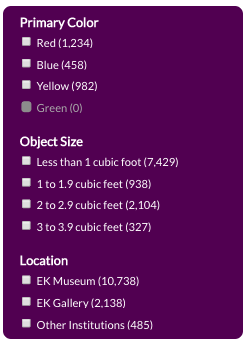As explored in my previous blog post How Faceted Navigation Works, facets allow you to quickly and efficiently sort through your content to find the information or data that you need. Facets largely mirror taxonomic structures, and business taxonomies are a great jumping-off point in the facet development process. One of the benefits of faceted navigation is that it can also reveal all the different ways your data can be spliced and grouped, allowing for the discovery of trends and patterns in your data.
Say you’re a curator for an art museum and want to organize an exhibit focused more on form than subject. You want all featured works to be small in size, share a specific date range, and contain the color blue. What would otherwise be a complex seek-and-find process , search facets allow you to locate and group these objects quickly, and can also reveal information that would otherwise be hard to come by. Because of faceted navigation, you can uncover the answers to questions like how many works in the museum’s collection don’t contain the color blue? How many works are larger than ten cubic feet? What works are available for exhibition now and what works are abroad in other institutions? Knowing the answers to these questions will not only facilitate your exhibition planning, but also allow for an enhanced recordkeeping experience.
, search facets allow you to locate and group these objects quickly, and can also reveal information that would otherwise be hard to come by. Because of faceted navigation, you can uncover the answers to questions like how many works in the museum’s collection don’t contain the color blue? How many works are larger than ten cubic feet? What works are available for exhibition now and what works are abroad in other institutions? Knowing the answers to these questions will not only facilitate your exhibition planning, but also allow for an enhanced recordkeeping experience.
Navigational facets can provide anyone, regardless of prior knowledge or experience, with a high-level understanding of the current state of information. Keep in mind that facets can enhance the search process only so  much as they accurately reflect the information they’re typifying, so it’s vital that a content audit process is routinely practiced. While it’s obvious as to how institutions like museums and libraries can benefit from pattern detection, using faceted navigation to uncover trends and patterns in data is applicable to other businesses, institutions, and endeavors, and is a great way to quickly understand those trends, especially from the position of a non-expert user. Facets not only facilitate finding, but also answer any ‘whats’ an individual may have about the data they’re looking through.
much as they accurately reflect the information they’re typifying, so it’s vital that a content audit process is routinely practiced. While it’s obvious as to how institutions like museums and libraries can benefit from pattern detection, using faceted navigation to uncover trends and patterns in data is applicable to other businesses, institutions, and endeavors, and is a great way to quickly understand those trends, especially from the position of a non-expert user. Facets not only facilitate finding, but also answer any ‘whats’ an individual may have about the data they’re looking through.
Other common features of faceted navigation can provide insight into the relationships existing amongst information from a high-level view. For example, nested facets moonlight as figurative breadcrumbs, allowing the user to see what parent-child relationships occur within the information. The inclusion of the number of matching results for each value can highlight relational proportions amongst those groups of information.
 Regardless of your organization’s goals (assembling exhibitions and otherwise), using enhanced faceted navigation to identify trends in your data will prove itself to be a beneficial practice to implement on a regular basis. It’s one thing to know what your data is, but another thing altogether to know and understand the relationships existing amongst your data and, better yet, to discover new relationships. End users and data managers alike are more capable of proper data interpretation because a heightened ontological understanding of the data is made obvious and accessible. As a result, your users will spend less time looking for information, less time recreating information that existed but of which they were unaware, and more time identifying connections that can lead to greater innovation and a competitive advantage.
Regardless of your organization’s goals (assembling exhibitions and otherwise), using enhanced faceted navigation to identify trends in your data will prove itself to be a beneficial practice to implement on a regular basis. It’s one thing to know what your data is, but another thing altogether to know and understand the relationships existing amongst your data and, better yet, to discover new relationships. End users and data managers alike are more capable of proper data interpretation because a heightened ontological understanding of the data is made obvious and accessible. As a result, your users will spend less time looking for information, less time recreating information that existed but of which they were unaware, and more time identifying connections that can lead to greater innovation and a competitive advantage.
The goal of a search feature is to connect users to content, and if facets can assist in that manner, while also shedding light on the kinds of content available, users are more informed and consequently have a more pleasurable search experience. From the outset, there’s a tighter relationship between search, browse, and find with faceted navigation. Trends and patterns are made both apparent and visible to the user, and not only can information be located more efficiently with the implementation of facets, but the user immediately has a surface-level understanding of the types of information available.
This post is an exploration of how facets can reveal patterns in your data. Other factors, like a customized search strategy and an enterprise-wide taxonomy, allow for an even better search experience. If this is something you’d like to speak with the experts at EK about, reach out to info@enterprise-knowledge.com.
